Jude Ratnam reveals an unknown truth about the war
Sri Lanka’s first and only documentary film to go to prestigious Cannes Film Festival this year, Jude Ratnam’s ‘Demons in Paradise’, a mostly biographical cinematic venture, unearths the grisly bitter truth about Sri Lanka’s war from the point of view of an ‘insider’.

French producer Julie Paratian and director Jude Ratnam pose during a photocall for the film ‘Demons in Paradise’ at the 70th Cannes Film Festival in France.
Actual facts and real life incidents with classic cinematography–a montage of the sights, smells, and sounds of a war ravaged country- ‘Demons in Paradise’ is a true depiction of honest cinema.
Jude was nominated for twp awards; Golden Camera and Golden Eye at the Cannes.
A film that was made for ten years from 2007 is a story of the ethnic war that could be seen within and outside.
The connection between the North and the South and peace and the war is made using the railway system of Sri Lanka.
“I thought railway lines could be a good metaphor to tell about the conflict in this country.
This is specially because the railway is connected to the colonial past as well,” says Jude Ratnam.
The film starts with a few old archaic film shots taken probably from the Government Film Unit.
They include how the British blasted rocks to make the railway lines to the hill country and there onwards throughout the film railways play a key role.
“I am fascinated by trains and I don’t know why the cinema had to be started with trains.
You must ask that question from Lumiere brothers themselves,” giggles Ratnam laughing at his own madness for the railway and of course for cinema reels as well.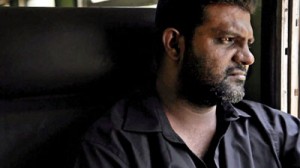
The film does not stop dealing with violence inflicted by Sinhalese on Tamils but Tamils among themselves as well, thus winning the wrath of extremists in both communities and becoming a traitor to the country and to ethnicity.
“Whenever I see the films about war there is a victim and a victimizer.But deep inside I knew that was just a half truth.robably this comes out of the social activism I was involved in as well,” says Ratam.
As a 6-year-old Jude witnessed the riots and war and was forced to hide in neighbours’ bathrooms to save his life during the 1983 riots.
Son of an Anglican priest, Jude was born in Colombo. Since his father was a religious leader posted in different places he went to Kandy.
In 1982 the family returned to Colombo but had to flee to Batticaloa to save their lives during the 1983 riots. “Our house was burnt and we were hidden by some Sinhala families.
“Having seen the flames of burning shops and houses that belonged to Tamils my brother and I were excited without knowing what was happening.
It was at that point my mother shouted at us don’t shout in Tamil they will kill us,” Ratnam says referring to an almost the same dialogue that comes in his film.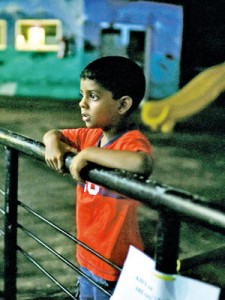
Before becoming a filmmaker Jude became a medical salesman trying to sell anaesthetic equipment. “But I couldn’t sell anything.
Some days I walked and walked but couldn’t sell a single equipment,” fed up with the job he gave it up it.
Then he joined the National Christian Council where he started working for human rights and went around the country.
“I was travelling all over the country and it was during this time that I realised the reality as to what was happening around the country,” Jude says.
According to Jude artistes have to be born and art houses cannot do the job of creating artistes. Art is in the genes of Jude as many of his seniors in the family were involved in writing, singing, theatres and many other aesthetic fields.
“My grandfather M. S. Ratnam was a poet, writer, chorister and a cinema actor. My father was inspired by him.
The film mainly narrates around Jude’s uncle, S. Manorajan, former fighter and a well-known journalist in Sri Lanka and now based in Canada.
The film captures the return of Manorajan and going to his original house in Kandy and visiting Sinhala families who rescued him and his family during earlier violence in 1977.
“The brutality among the Tamil community is worse than the brutality of Sinhala community on Tamils. This hard truth was taught to me by my uncle Manorajan, a journalist,” Jude says analyzing the bitter truth he discovered.
This he proves with one of the final scenes where he brings together a group of former fighters around a campfire who confessed what they did and what they saw.
Talking about his film going to France, Jude says how it went to France itself was a magical story. “I came out with this film idea at a film workshop and a lady who was there said that it could be taken to French film school, La Femis which made an exception for a non-European film,”.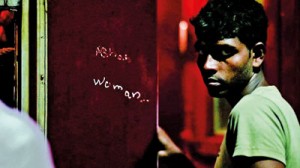
He was also lucky to meet Thierry Garrel who had come down to Sri Lanka on a holiday.
Garrel is known as the godfather of French documentary cinema and having seen rushes of two sequences he agreed to help Jude.
With ‘Yahapalana’ government in operation Jude is hopeful that he will be able to screen his film in Sri Lanka.
“I hope it will be possible to screen it here. I wanted to break the misconception that a documentary is boring and prove that it can be intellectually challenging.
In addition to uncle, Ratnam’s father, mother and many relatives are features in the film. In a number of scenes he himself is featured and this was after persuasion by his producer Julie Paratian.
At Cannes Jude’s film received rave reviews and warm welcomes by some Sri Lankan domiciles as well.
Jude Ratnam “I am the first Tamil director to make a film from within the country. Ironically, my experience of being displaced as a child and as an adult, and my resulting knowledge of both the Tamil and Sinhalese communities, made this film possible,” he told the media there.
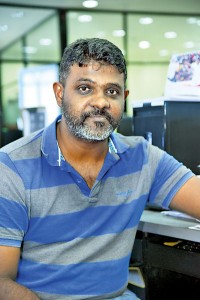
Jude Ratnam
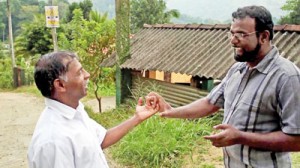
Ratnam’s uncle S. Manarajan (Right) meeting a Sinhala friend in Kandy


